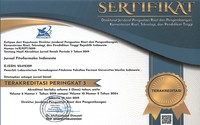Postprandial Bioassay and Radical Scavenging on n-Hexane Fraction of Cordia myxa L. Leaf
Abstract
Full Text:
PDFReferences
Anonim 2017 WHO | Global report on diabetes WHO
Endrini S, Rahmat A, Ismail P and Taufiq-Yap Y H 2007 J. Med. Sci.
Halim M and Halim A 2019 Diabetes Metab. Syndr. Clin. Res. Rev. 13 1165–72
Chinsembu K C 2019 J. Herb. Med. 15 100230
Mohammed A, Ibrahim H and Islam M S 2017 Products Chemistry vol 54, ed Atta-ur-Rahman (Elsevier) pp 291–314
Yousef Nasab F, Hajinezhad M R, Hashemi H and Miri A 2017 Orient. Pharm. Exp. Med. 17 291–5
Najib A, Ahmad A R and Handayani V 2019 Pharmacogn. J. 11 358–61
Malik A and Ahmad A R 2016 Int. J. PharmTech Res 9 268–75
Najib A, Hartati S and Elya B 2011 Int. J. PharmTech Res. 3
Chiu C-Y, Hsu W-H, Liu H-K, Liu S-H and Lin Y-L 2018 J. Funct. Foods 41 210–5
Zamani M, Moradi Delfani A and Jabbari M 2018 Spectrochim. Acta Part A Mol. Biomol. Spectrosc. 201 288–99
Kandi S and Charles A L 2019 Food Chem. 287 338–45
Hara K, Someya T, Sano K, Sagane Y, Watanabe T and Wijesekara R G S 2018 Data Br. 17 870–5
Balan K, Perumal P, Sundarabaalaji N and Palvannan T 2015 J. Mol. Struct. 1081 62–8
Dewi Y, Mursalin and Najib A 2013 Int. Res. J. Pharm. 4 110–2
Najib A, Handayani V, Ahmad A R, Hamidu L and Anisa R 2019 J. Glob. Pharma Technol. 11 266–70
Waris R, Dewi Pratiwi E A and Najib A 2016 Int. J. PharmTech Res vol 9
Ramakrishnan P, Ramadoss D, Muthulingam P, Nedunchezhian R and Krishnamoorthy K 2017 J. Young Pharm. 9 321–6
Najib A, Handayani V, Ahmad A R, Hamidu L and Anisa R 2019 J. Glob. Pharma Technol. 11 266–70
Hidalgo M, Sánchez-Moreno C and Pascual-Teresa S de 2010 Food Chem. 121 691–6
Abdi H 2010 Wiley Interdiscip. Rev. Comput. Stat. 2.
DOI: https://doi.org/10.33096/jffi.v9i3.917
Copyright (c) 2022 Virsa Handayani

This work is licensed under a Creative Commons Attribution-ShareAlike 4.0 International License.
Indexed by:
ISSN: 2356-0398 | e-ISSN: 2541-2329
Editor's Address:
Third Floor Pharmacognosy-phytochemistry laboratory building, Urip Sumoharjo road km. 5 Campus II UMI, Makassar, South Sulawesi, Indonesia
Phone: +6281524045514
Fax: +62411425619
E-mail: editorjfi@umi.ac.id

















.jpg)

